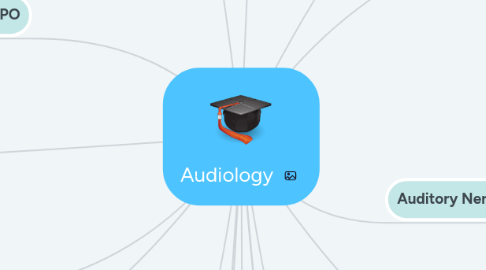
1. CASLPO
1.1. Guidelines
1.2. Standards
1.3. Essentials for assessment
2. The Middle Ear
2.1. The Ossicles
2.1.1. Malleus
2.1.1.1. head and neck
2.1.1.2. 3 processes
2.1.1.2.1. manubrium
2.1.1.2.2. anterior process
2.1.1.2.3. lateral process
2.1.2. Incus
2.1.2.1. body
2.1.2.2. 2 processes
2.1.2.2.1. anticular fasset
2.1.2.2.2. lenticular process
2.1.3. Stapes
2.1.3.1. smallest bone in the human body
2.1.3.2. 2 crura
2.1.3.2.1. posterior
2.1.3.2.2. anterior
2.2. 2 windows
2.2.1. Round
2.2.1.1. opens to basal turn of the Scala tympani
2.2.2. Oval
2.2.2.1. opening to inner ear
2.3. Muscles that support the ossicles
2.3.1. Stapedious
2.3.2. Tensor Tympani
2.4. Eustachian Tube
2.4.1. 36mm
2.4.2. vents middle ear to nasopharynx
2.4.3. opens every min while awake, every 5 mins while sleeping
2.5. Disorders
2.5.1. Otitis Media
2.5.1.1. infection of mucous lining
2.5.2. facial palsy
2.5.3. barotrauma
2.5.4. cholesteotoma
2.5.5. otosclorosis
2.5.6. ossicle deformities
3. Hearing Loss
3.1. Conductive
3.1.1. associated with middle or outer ear
3.1.2. Normal bone conduction, abnormal air conduction
3.2. Sensory Neural
3.2.1. associated with inner ear
3.2.2. MADS is a form of this (chronic form of otitis media)
3.2.3. abnormal air and bone conduction results, no air-bone gap
3.3. Mixed
3.3.1. abnormal air and bone conduction results, there is an airbone gap
4. treatments
4.1. antibiotics
4.2. myringotomy
4.3. mastoidectomy
4.4. tympanometry
4.5. spaedectomy
4.6. stapes mobilization
5. NIHL
5.1. prolonged exposure to loud noises
5.2. use earphones not earbuds
6. Medical Imaging
6.1. PET
6.2. MRI
6.3. CT
7. Physical Examination
7.1. Visual
7.1.1. looking for any discolouration or physical deformities
7.2. Otoscope
7.2.1. perfortation
7.2.2. debris
7.2.3. stenosis
7.2.4. excessive cerumen
7.2.5. foreign bodies
7.2.6. external otitis
7.2.7. thickening of the tympanic membrane
8. Acoustic imittance testing
8.1. Static acoustic compliance
8.2. acoustic reflex
8.3. tympanometry
9. The Outer Ear
9.1. Pinna
9.1.1. Disorders
9.1.1.1. Anotia/microtia
9.1.1.2. keloids
9.1.1.3. tumour
9.1.1.4. periocondritus
9.1.1.5. hematoma
9.2. EAC
9.2.1. Disorders
9.2.1.1. stenosis
9.2.1.2. atresia
9.2.1.3. mastoiditis
9.2.1.4. otomicosis
9.3. Tympanic Membrane
9.3.1. Disorders
9.3.1.1. perforation
9.3.1.2. thickening
9.3.1.3. myringitis
10. The inner Ear
10.1. Vestibular
10.1.1. balance
10.1.1.1. motion sickness
10.1.1.2. vertigo
10.1.2. managed in cerebellum
10.2. Cochlear
10.2.1. hearing
10.2.2. transmission of mechanical energy
10.2.3. unrolled cochlea diagram
10.3. Vestibular System
10.3.1. 3 semicircular canals
10.3.2. utricle and saccule
10.3.3. perilymph, endolymph
11. Auditory Pathway
11.1. Internal auditory canal
11.2. Cochlear nucleus
11.3. Superior olivary complex
11.4. Lateral liminiscus
11.5. Inferior colliculus
11.6. Medulla Oblongata
11.7. Auditory complex
11.8. Brain
12. Auditory Nerve DIsorders
12.1. Symptoms
12.1.1. tinnitus
12.1.2. high frequency hearing loss
12.1.3. unilateral loss
12.1.4. excessive speech recognition difficulties
12.2. Sensory Neural Hearing Loss
12.3. Acoustic Neuroma
12.3.1. affects 8th cranial nerve
12.3.2. affects both ipso and contra lateral acoustic reflex
12.3.3. treatment
12.3.3.1. wait and see
12.3.3.2. observation
12.3.3.3. surgery
13. Testing
13.1. Pure Tone Audiometry
13.1.1. Pressure applied to one side
13.2. Speech Audiometry
13.2.1. can indicate a problem along the auditory pathway
13.3. OAE
13.3.1. measures sounds that echo back from hair cells
14. CAPD
14.1. Caused by middle ear otitis media
14.2. obscure auditory dysfunction
14.3. ability to comprehend spoken langauge
14.4. slow to respond
15. Physiological Testing
15.1. Involuntary stimulus with an automatic response
15.1.1. OAE
15.1.2. Immittance
15.1.3. ABR
16. Behavioural Testing
16.1. Subject makes a voluntary response when a signal is presented
16.1.1. Pure tone
16.1.2. Speech Audiometry
